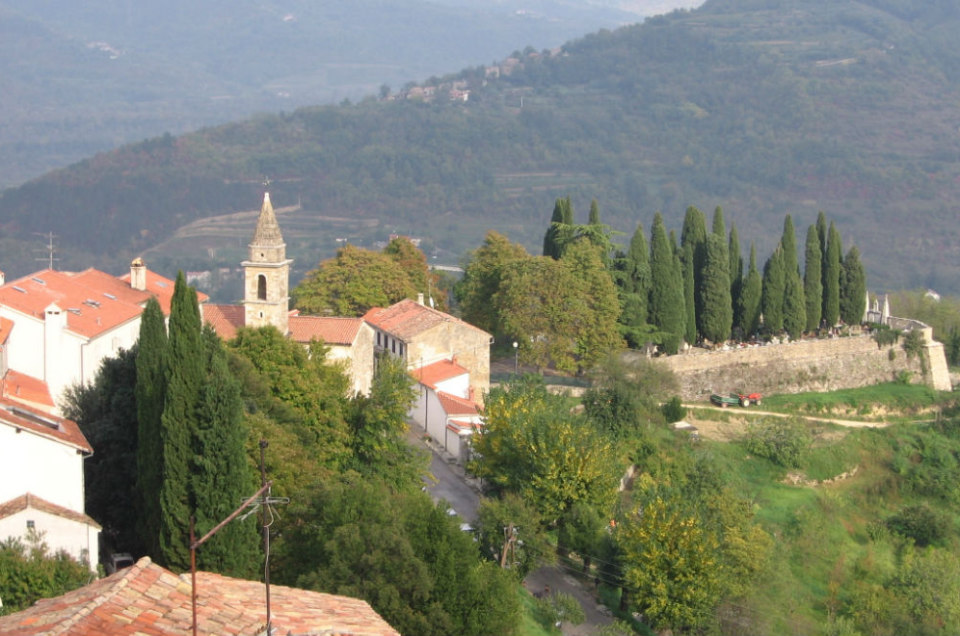Truffles: that enigmatic gourmet ingredient that sends chefs and the food cognoscenti alike into culinary euphoria. Those that enjoy it get almost misty-eyed at the thought of the tubers that grow in harmony with tree roots 5-20 centimeters underground, being shaved in paper thin slices atop their favourite dish. How sought after are these “earth apples,” as they are sometimes called? In 2007, Stanley Ho, a casino owner in Macau paid $330,000 US for a 1.5 kg truffle. Today, fresh white truffles can fetch up to $10,000/kilo and hungry diners looking to savour that mysterious, earthy, mushroom-like nuance are willing to pay the price.
Italy and France are the usual suspects when one thinks of world-class truffles, but Croatia’s Istria region is where to find truffles; arguably some of the world’s finest white truffles or Tuber Magnatum Pico, in fact. I stumbled onto this fact when my husband and I drove into Buzet and read a sign proclaiming it “The City of Truffles.” Being fans of the tuber, we felt like we’d won the culinary lottery! What we unearthed was a proud, rich tradition of truffle hunting and gastronomic history dating back to Roman times in this region.
It’s plain to see why the interior of Istria is often compared to Italy’s Tuscany (at a fraction of the price, I might add).
Rolling, verdant hills with proud, medieval towns standing sentry to the valley activity below can easily be Tuscany’s filmic body double. It’s here, in the valley’s damp Motovun Forest, kept moist by the flowing Mirna River that truffles grow under oaks, willows, poplars and lime trees. Once they emit their scent, trained dogs sniff out the precious loot hidden beneath the forest floor.
White truffle season can start in late summer with the peak hitting in autumn and continuing through till early winter. As its mid-autumn in Istria, we’re in truffle heaven. We head to the nearby town of Livade (home of the Guinness Book of Record truffle found in 1999) where an inn called Konoba Dolina, serves delicious, hearty Istrian fare with fresh ingredients. Konobas, by the way, are a fantastic way to enjoy local, authentic fare at fair prices. We order Istrian pršut (local prosciutto to rival any cured by the northern Bura winds), cheese from the isle of Pag and fuži- hand rolled, tube like pasta covered in vrhnje (cream with a crème fraîche tang) and a cloud of local black truffle slivers. Gloriously simple and absolutely delicious- this is food that lingers on the senses long after you’ve savoured the last bite!
Truffles are best enjoyed raw- shaved atop pasta, eggs and some meat dishes. I ask Wanda Srdoc, a Canadian truffle importer with family ties in Istria, what makes the region’s truffles unique. In Alba for example, says Srdoc, it’s primarily the oak tree that produces the prized white truffle. In Istria, “The Motovun Forest’s rich diversity of trees is over and beyond what’s available in Alba or Piedmont. This diversity, our climate and soil produces truffles with unique flavours, textures and character that reminds me of fine wine.”
Istrian truffle expert Radmila Karlić adds “Istrian truffles are richer in structure, heavier and have a much stronger scent. In fact, they probably have the strongest scent when compared to any other truffle in the world.” Purists and fans of the tuber might want to note that for years, Croatians sold their truffles to Italy, where they were re-packaged as “Italian truffles” for sale on the international market. While Italy and France’s well-oiled marketing machine has fuelled their truffle industry, Croatia is now embracing its “Istrian Gold.” Yearly festivals highlighting the product’s quality and versatility are attracting gastro-tourists with a taste for the good life.
If you happen to be in Buzet the second weekend of November, bring your stretchy pants and get ready to dig in because the town makes an omelet or “Fritaja” of note. In 2012, it will be made with 2012 eggs and you guessed it, a whole lot of truffles! For a full listing of truffle festivals, restaurants and culinary experiences, go to www.istria-gourmet.com for details. And should you miss truffle season altogether, worry not. Srdoc’s family offers locals and visitors alike the opportunity to savour the flavour of the region’s bounty through their Natura Tartufi products- some of which I picked up in Motovun in the form of “crema” or a mushroom and truffle paste and truffle honey. As they say in Croatia, “Dobar Tek” (or bon appétit) and don’t forget to sample a glass of the local white Malvasia wine to fully engage in Istria’s culture of living and eating well.
The Do’s and Don’ts of Buying, Savouring and Storing Fresh White Truffles:
* Toronto-based Chef Rob Gentile of the Italian restaurant Buca Osteria and Enoteca says, “When selecting truffles, I smell, feel and look for worm holes and moisture build up (soft spots). Fresh truffles should be dry, very strong in odor and hard to the touch.”
* A good white truffle should never be “warty.” It will be bulbous, flattened in parts or uneven with pale yellow or gold colour- never grey.
* Do not store white truffles in rice- the rice will dry out your precious purchase.
* Do wrap in a dry, clean rag.
* Eat within 10 days- a fresh white truffle should NOT be kept for months. It will be a shadow of its former, full-flavoured self.
* Do not freeze a fresh white truffle; conserve it in oil (where it can ferment) or in pickling juices. It will lose its characteristics, taste and aroma.
* Do not scrub, peel the skin or boil prior to using. Do serve by cutting into thin slices raw and serve atop your favourite dish.
* FYI: If you’re buying Truffle Oil- make sure know what you’re getting. Today’s “truffle oil” is olive or grapeseed oil enhanced with artificial truffle “essence” (not real truffles) a.k.a. the organic compound called 2,4-Dithiapentane.
